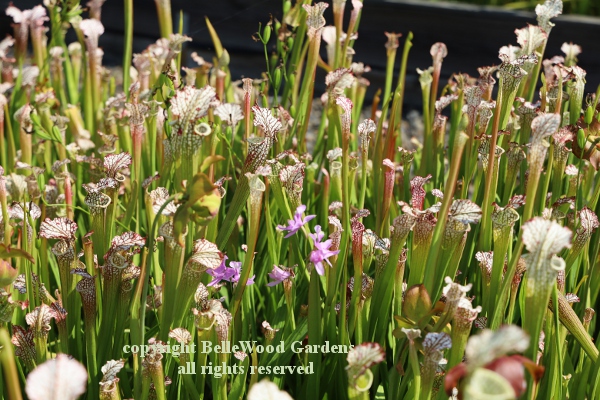
Sarracenia leucophylla with a native little bog orchid, Calopogon tuberosus.
.
If you have any comments, observations, or questions about what you read here, remember you can always Contact Me
All content included on this site such as text, graphics and images is protected by U.S and international copyright law.
The compilation of all content on this site is the exclusive property of the site copyright holder.
Sarracenia at Aquascapes Nursery
Friday, 26 July 2019
This should have been an entry for Wednesday, 24 July, which is when the Tohickon Garden Club visited Aquascapes Unlimited, a wholesale aquatic plant nursery in Pipersville, Pennsylvania. They did go. And I was there. Back home and with absurd ineptitude I A) looked at all the images I took and then B) formatted the card before transferring them to the computer. Thus deleting everything that was on the card. Eeek! Fortunately Randy Heffner, nursery proprietor, and I are friends of many years standing. I e-mail, explained my faux pas, and asked if I could return to try this all over again. And yes, I could. So yes, I did.
Our Wednesday visit began with an interesting, informative talk
about sarracenia, a native North American insectivorous plant.

Sarracenia leucophylla with a native little bog orchid, Calopogon tuberosus.

The orchids are a "weed" in the large outdoor growing beds, of which these are only some.
The sarracenia are sold to wholesale florists as cut material, priced at $1 each in bunches
of 10, minimum order $200. Exotic, long lasting, and selling them from cultivated material
takes the pressure off the already threatened habitats from which wild material is taken.
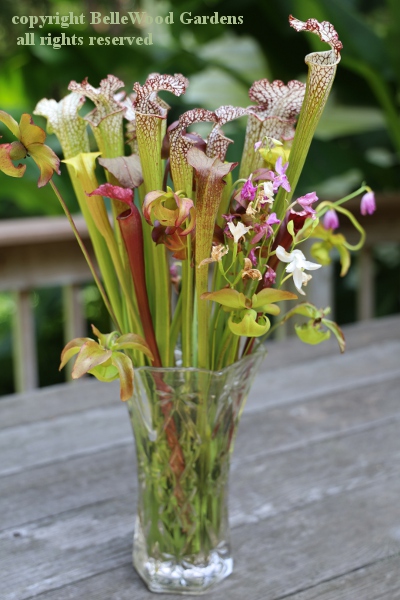
Randy's wife, Mariellen, had cut some sarracenia for a table display on Wednesday.
On Friday, he sent me home with it. The sarracenia were still crisp the following week.
Sarracenia grow in bogs. As Randy describes it, "Wet feet, dry ankles." Their roots go down into the wet conditions but the crown (where shoots go up and roots go down) must be dry. They need acidic conditions. The combination means nutrients are very limited. Insectivorous plants such as the sarracenia developed the ability to attract insects, lure them down into their hollow leaves where they drown and are digested. Unlike Audrey, feeding meat to a sarracenia or a Venus flytrap will kill them. And only rain water or distilled water as tap water is unsuitable.
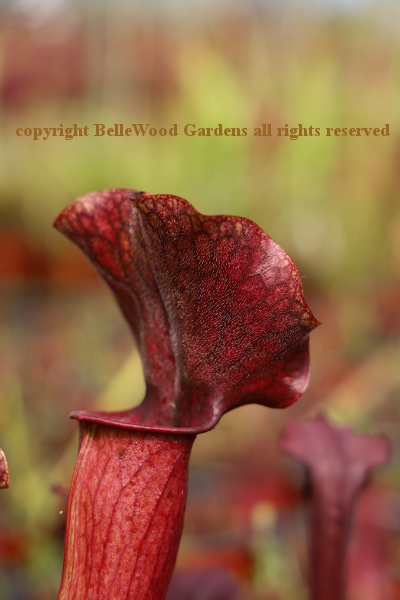
Can you make out the fine little downward pointing hairs on the hood?
Gnats, a fly, a small moth, attracted by a sweet scent, land and find
a slippery slope down to the digestive soup from there is no escape.
After the lecture and a tour of the facilities there is a workshop
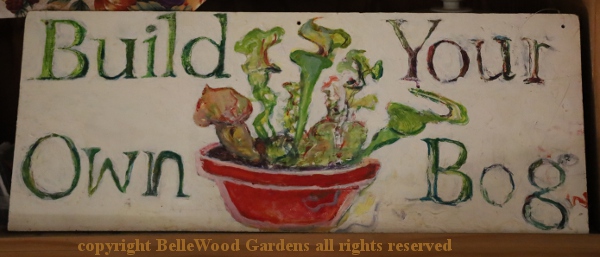
where those who have paid a materials fee can build a bog to take home.
 .
.
Terra cotta bowl, liner, special substrate, and several plants
In his talk Randy explained that there are eight species of sarracenia (even one, Sarracenia purpurea native as far north as Alaska and Canada.) They frequently hybridize in the wild. Offspring are fertile, and may cross-pollinate, with very complex ancestry for the offspring. Randy began by crossing the species to recreate the naturally occurring hybrids.
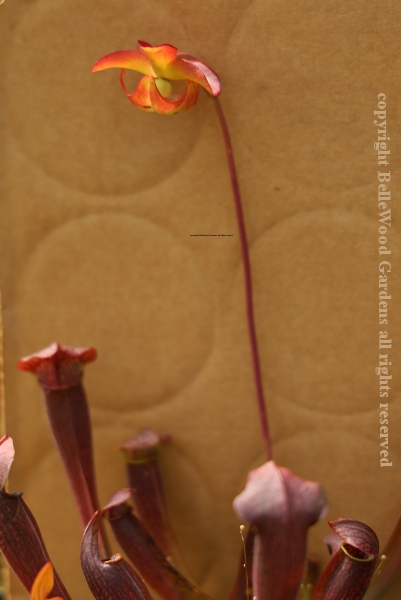
As if the leaves, those hollow pitchers, of sarracenia are
not sufficiently exotic, their flowers are also quite attractive.
Seed is readily produced and then easily germinated too.
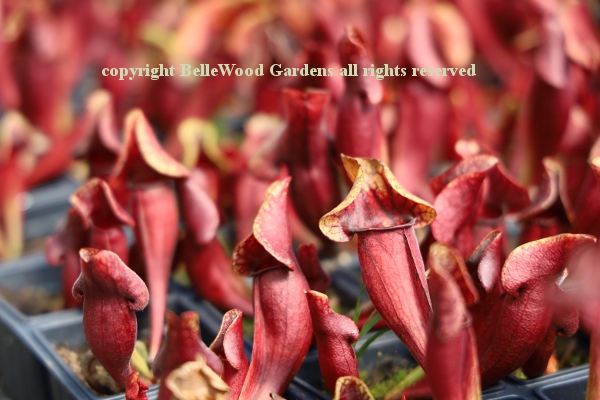
Immature little sarracenia, potted up, in a shallow, water-filled greenhouse bench.
 .
.
Sarracenia leucophylla has red veined white tubes, protected with an arching hood.
Completely flushed with red, this indicates the diversity other sarracenia can present.
 .
.
Hybrids, but I don't know if these are first generation crosses, or more complex hybrids.
Notice that the hood which covers the hollow pitcher is upright, meaning rain can enter.
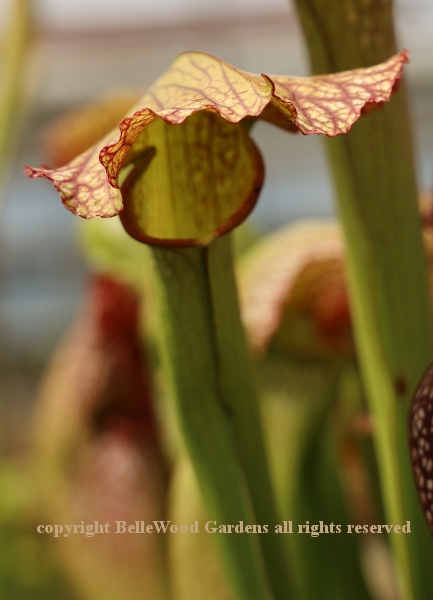 .
.
On the left, the very wide, somewhat ruffled hood reminds me of a cobra. On the right - not sure
but perhaps it is Sarracenia ×catesbei, a naturally occurring hybrid of Ss purpurea x flava.
Insectivory is a survival technique that other plants evolved.
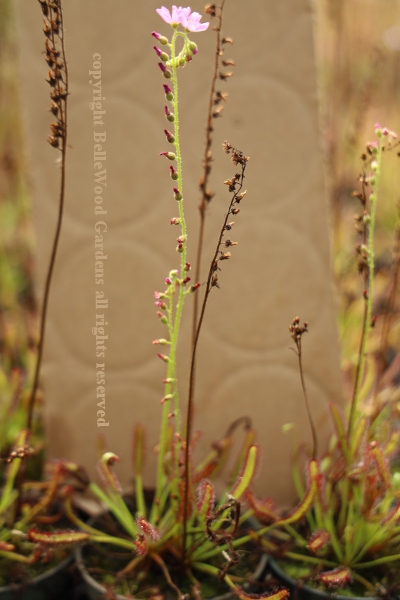
Think of sticky fly paper. The leaves of Drosera - down near the pot -
have sticky hairs that attract and catch insects. They actually bend
over their prey. I wonder, would they catch aphids in my greenhouse?
As the sign in Randy's office states, "So many species, so little time."
Aquascapes Unlimited Nursery grows other aquatic plants too, as you can see here
Back to Top
Back to July 2019
Back to the main Diary Page